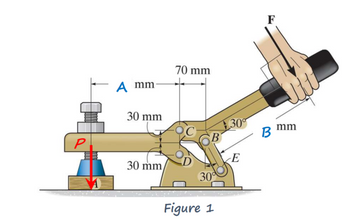
Elements Of Electromagnetics
7th Edition
ISBN: 9780190698614
Author: Sadiku, Matthew N. O.
Publisher: Oxford University Press
expand_more
expand_more
format_list_bulleted
Concept explainers
Question
For the clamping device shown calculate the force in Member BE if F=133, A=288, and B=322. Also solve for the clamping force "P" exerted at Point A. Include Complete FBD.

Transcribed Image Text:### Transcription of Figure 1: Manual Lever Mechanism
Figure 1 displays a manual lever mechanism used for applying force onto a workpiece. Below is a detailed explanation of the components and dimensions as depicted in the illustration:
- **Handle and Force Application (F):** A hand is shown applying force (F) downward on a handle.
- **Lever Components:**
- **A mm and B mm:** These are variable dimensions indicating parts of the lever arm where specific measurements can be adjusted as needed. "A" denotes the horizontal distance from the pivot to the point of load, while "B" is the horizontal distance from the pivot to the handle.
- **30° Angles:** These indicate the pivot angles at points where the lever bends, ensuring mechanical advantage and proper force application.
- **Pivot Points:**
- **C and B:** These are the main pivot points on the lever arm with links that transfer applied force.
- **D and E:** These serve as secondary pivots connecting lever segments and base.
- **Force Transmission (P):** A red arrow (P) shows the direction of force applied onto a workpiece positioned beneath a clamp. The force is transferred vertically downwards, aided by the lever mechanism.
- **Dimensions:**
- **70 mm and 30 mm Measurements:** These are fixed measurements on the lever mechanism, indicating lengths and spacing between pivots along the lever.
This entire lever mechanism shows a practical application of mechanical advantage principles, where a small amount of force applied at the handle (F) generates a larger force (P) at the workpiece, enhancing operational efficiency.
Expert Solution
arrow_forward
Step 1
The value of P is 102.34N
Step by stepSolved in 3 steps with 3 images

Knowledge Booster
Learn more about
Need a deep-dive on the concept behind this application? Look no further. Learn more about this topic, mechanical-engineering and related others by exploring similar questions and additional content below.Similar questions
- Problem 3. Determine the vertical clamping force at E in terms of the force F applied at the handle. E is in smooth contact with the ground. (Hint: Look for two-force members) a/2 h - 1.5 a |C 60 DE a/2' 1.5 aarrow_forwardSolutions must be based solely on the method of sections. 1. Find the force in member AF. D 3P 2d E 3P 2d B 2P- 2d E 3darrow_forwardThe needle-nose pliers are used to either cut objects at location A or grip objects at location B. Compute (a) the cutting force at A and (b) the gripping force at B in terms of the applied force F. Determine the magnitude of the pin reaction at O in both cases. Neglect the effects of the slight opening of the jaws to accommodate the gripped items. B Answers: 66 mm 14 mm A O (a) The cutting force at A: 103 mm FA i (b) The gripping force at B: FB = i F F F The pin reaction at O: Fo- i F The pin reaction at O: Foi F Farrow_forward
Recommended textbooks for you
 Elements Of ElectromagneticsMechanical EngineeringISBN:9780190698614Author:Sadiku, Matthew N. O.Publisher:Oxford University Press
Elements Of ElectromagneticsMechanical EngineeringISBN:9780190698614Author:Sadiku, Matthew N. O.Publisher:Oxford University Press Mechanics of Materials (10th Edition)Mechanical EngineeringISBN:9780134319650Author:Russell C. HibbelerPublisher:PEARSON
Mechanics of Materials (10th Edition)Mechanical EngineeringISBN:9780134319650Author:Russell C. HibbelerPublisher:PEARSON Thermodynamics: An Engineering ApproachMechanical EngineeringISBN:9781259822674Author:Yunus A. Cengel Dr., Michael A. BolesPublisher:McGraw-Hill Education
Thermodynamics: An Engineering ApproachMechanical EngineeringISBN:9781259822674Author:Yunus A. Cengel Dr., Michael A. BolesPublisher:McGraw-Hill Education Control Systems EngineeringMechanical EngineeringISBN:9781118170519Author:Norman S. NisePublisher:WILEY
Control Systems EngineeringMechanical EngineeringISBN:9781118170519Author:Norman S. NisePublisher:WILEY Mechanics of Materials (MindTap Course List)Mechanical EngineeringISBN:9781337093347Author:Barry J. Goodno, James M. GerePublisher:Cengage Learning
Mechanics of Materials (MindTap Course List)Mechanical EngineeringISBN:9781337093347Author:Barry J. Goodno, James M. GerePublisher:Cengage Learning Engineering Mechanics: StaticsMechanical EngineeringISBN:9781118807330Author:James L. Meriam, L. G. Kraige, J. N. BoltonPublisher:WILEY
Engineering Mechanics: StaticsMechanical EngineeringISBN:9781118807330Author:James L. Meriam, L. G. Kraige, J. N. BoltonPublisher:WILEY

Elements Of Electromagnetics
Mechanical Engineering
ISBN:9780190698614
Author:Sadiku, Matthew N. O.
Publisher:Oxford University Press

Mechanics of Materials (10th Edition)
Mechanical Engineering
ISBN:9780134319650
Author:Russell C. Hibbeler
Publisher:PEARSON

Thermodynamics: An Engineering Approach
Mechanical Engineering
ISBN:9781259822674
Author:Yunus A. Cengel Dr., Michael A. Boles
Publisher:McGraw-Hill Education

Control Systems Engineering
Mechanical Engineering
ISBN:9781118170519
Author:Norman S. Nise
Publisher:WILEY

Mechanics of Materials (MindTap Course List)
Mechanical Engineering
ISBN:9781337093347
Author:Barry J. Goodno, James M. Gere
Publisher:Cengage Learning

Engineering Mechanics: Statics
Mechanical Engineering
ISBN:9781118807330
Author:James L. Meriam, L. G. Kraige, J. N. Bolton
Publisher:WILEY